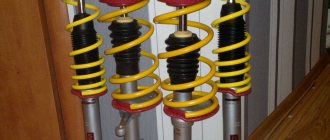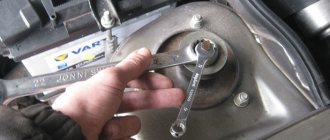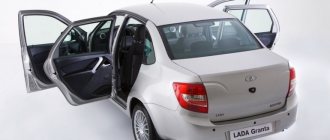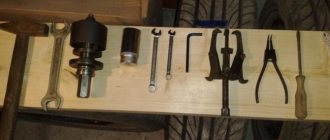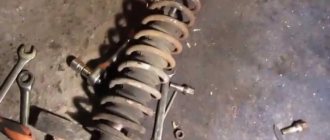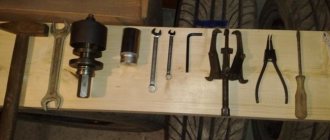July 19, 2020 Lada.Online 16 164 3
Rear suspension with coil springs, double-acting telescopic hydraulic shock absorbers and trailing arms elastically connected by a transverse beam and a stabilizer bar. The following are instructions on how to change the rear shock absorbers and springs on a Lada Granta, Kalina 2 and Priora yourself.
The replacement process is shown on a Lada Granta car. For other models everything is done similarly.
When should you resort to repairing your car's depreciation system?
If the car is just from the showroom, then it still has the technical potential given to it; when the factory settings are functioning, the control system works flawlessly. It is very pleasant and comfortable to be in the car. But the situation changes dramatically when the car crosses the “Rubicon” of active operation for six months or a year. It seems that everything is starting to “crumble”, something is already tapping. And often an acute problem arises when you urgently need to decide where and how to change the rear struts on a Lada Kalina, purchasing the necessary components on the car market.
Shock absorption system
How to make sure the rack is working properly?
Sometimes it is impossible to visually determine the cause of extraneous noise when the car is moving. For example, the rear pillars of the Lada Kalina are clean, without any oil stains. Rocking also does not allow one to unambiguously diagnose a malfunction. However, the knocking noise in the rear suspension area does not disappear.
In this case, you will have to drive the car onto a vibration stand. It simulates road irregularities, and special sensors monitor how various suspension elements perform. The data is transmitted to a computer, which draws conclusions about the serviceability of the racks. This pleasure, of course, is not free, but it won’t hit your wallet very hard either. The cost of computer diagnostics depends on the region and is within a couple of thousand rubles. But for this money, the owner will receive data not only on the condition of the shock absorbers, but also all components of the front and rear suspension, which is especially important if there is a long trip ahead.
What will make a car enthusiast think?
- The situation is if you often have to drive off-road, on poor asphalt surfaces, when the vehicle’s suspension is subject to the aggressive influence of potholes, holes, and sharp soil. Initially, the car still resists the “traps” of poor-quality road surfaces, and then many parts become unusable: they either rust, or become covered with cracks, or succumb to rupture.
- Buying a used car. The seller is not always conscientious, and it is not necessary that he previously monitored the technical condition of the vehicle, thought about how to change the rear struts on Kalina, or eliminate emerging problems. Used cars are a lottery, and you can lose if you don’t have a minimum of knowledge about repairs and maintenance of the domestic automobile industry.
- Frequent changes of drivers. This is the situation when several people alternately drive one family car, especially when there are also novice drivers who have recently received a license and do not know how to change the rear struts on a Kalina; the profile video for them is just beginning to open up new horizons in understanding the structure of the car.
- A machine that sits idle for a long time has a negative impact on its rubber parts. And before you start an active driving period again, it is worth checking all its control systems to see if they are acceptable for use and if their condition is safe.
- Unfavorable temperature conditions. Sudden changes in temperature and increased humidity levels will also force the driver to soon figure out how to change the rear struts on a Lada Kalina, having first checked them.
FakeHeader
Comments 18
crappy oil... the shock is checked by machine, not by hand. although according to the symptoms the left one is a corpse. And then, are the shock absorbers oil or gas oil? plus, as a rule, performance is not the main criterion, the main criterion is the presence of oil in the shock absorber... there is no point in lubricating the silent parts with oil, they should not rotate at all when in place. like the metal bushing in the rubber band... looking at the rubber in general, a question arises. how did you travel? With such silents, the bridge dangles like shit from an ice hole, the car jerks from side to side when pedaling the accelerator.
How many people, so many opinions. In my opinion, the oil is good. It's not clear by car. According to the main methods of verification, it is alive, but rather harsh. Ammorts Niva oil. The car behaved stably, did not dangle anywhere, only rumbled sometimes. After the second trip I went to check and saw that my ears were hanging on the lower rubber bands. Well, I changed it right away.
It will be useful: Removing and replacing front stabilizer struts ford focus 2
We opened up a couple of engines using Lukoil oil... the bed, the head... everything was covered in an even 3-4 mm layer of soot. dirt just settles in the engine... because... many people say that nivo-shocks themselves are harsher than classic ones, although I don’t know... I haven’t used them... in any case, if they work differently, I would recommend changing them... maybe the speeds were low, since I didn’t notice...
crappy oil... the shock is checked by machine, not by hand. although according to the symptoms the left one is a corpse. And then, are the shock absorbers oil or gas oil? plus, as a rule, performance is not the main criterion, the main criterion is the presence of oil in the shock absorber... there is no point in lubricating the silent parts with oil, they should not rotate at all when in place. like the metal bushing in the rubber band... looking at the rubber in general, a question arises. how did you travel? With such silents, the bridge dangles like shit from an ice hole, the car jerks from side to side when pedaling the accelerator.
By the way, Lil Mobil Ultra, which you pour. It turned out to be complete slag. After 3 thousand I drained the black slurry and had to flush the engine. So, it depends. In Luka, I’m at least sure that this is factory oil, and not a broken badya in the basement of the Khachami.
Greetings to all VAZ 2101-2107 classic car enthusiasts, dear readers of the RtiIvaz.ru blog. This video shows shock absorber bushings for the rear and front struts. Let's look at the rear strut bushings on YouTube video. This is a repair kit (11P) produced by OJSC "BALAKOVOREZINOTEKHNIKA" with catalog number 2101-2906231P. It is worth noting that there are also silent blocks for the lower eye of the rear shock absorber, but today we are not looking at them in the video.
The repair kit is supplied in a plastic bag. Let's cut it open and look at its contents. Yes, the package is protected by the “golden” label from the company Balakovorezinotekhnika. This repair kit includes eight rubber bushings for rear shock absorbers for VAZ 2101-2107 cars. When installing the rear pillars of classic vases, two bushings are installed in the upper eye of the pillar and two in the lower one, for a total of four bushings per rear pillar.
It should be noted that the factory bushings for the rear shock absorber have notches on the side, which “other” manufacturers do not have. At the same time, each factory rubber part must have a part number 2101-2906231 cast on it, which serves as brand protection
This auto repair kit includes: four rubber parts (“donuts”) and two silent blocks 2101-2905448Р (better known as iron “nuts”). When installing the front struts, two “donuts” are installed on top of the shock absorber - one at the bottom of the mudguard, the second at the top. Silent blocks are installed in the lower eye of the front pillar.
2101-2905448Р quantity 2 pieces, 2101-2905450Р quantity 4 pieces, 2101-2906231Р quantity 8 pieces
Hello, today we will tell you how to remove and replace the rear shock absorber and bushings on the rear shock absorbers on a VAZ 2105, 2107. Due to worn shock absorbers, the car will sway more and the quality of driving comfort will decrease. When the shock absorber bushings wear out, unpleasant knocking noises may appear in the rear suspension and they will have to be replaced. So let's get started. First, we drive the car into the “pit” or lift it on a lift. The rear wheel does not need to be removed. Now you need to unscrew 2 bolts, bottom and top of the shock absorber. It can be extremely difficult to unscrew the bottom bolt and it is better to buy a new bolt before replacing the shock absorber, because the old bolt may have to be cut off. After this, unscrew the bottom bolt
Signs indicating wear on the rear shock absorber struts
- Constant creaking, clearly visible even inside the car.
- Deterioration in vehicle maneuverability.
- A decrease in the level of comfort in the car interior, when bumps in the road are felt, the vehicle itself rides harshly.
- In the arched opening of the rear wheel, it is easy to distinguish water and oil stains, which means that the rear pillar can no longer cope with the loads.
Rear shock absorber strut
Knock in the front suspension of Lada Kalina
Many motorists dread the day when strange knocking noises appear in the suspension, especially the front suspension, which increases with increasing speed. Of course, there is reason to worry, but at the same time, a car’s suspension is a strong and reliable unit that will clearly withstand a few more kilometers to a service station or garage, where it can be diagnosed.
There are four main reasons for the occurrence of knocks and squeaks in the front suspension of the Lada Kalina. Of the three possible causes of knocking, two of them can be eliminated independently.
So, the first reason why a knocking sound may occur in the suspension is the quality of the road surface. Yes, suspensions, even the most ideal and new ones, can squeak and knock on a bad road, even if this has not been observed before. To test this theory, you should drive onto a well-paved road and drive a few hundred meters; if there is no knocking, everything is fine with the suspension; if not, look at the second reason.
The second reason for the knocking sound, if it is accompanied by vibration in the steering wheel, is a malfunction of the steering, or rather the steering rack, or thinning of the brake discs. If the discs can be replaced independently, then in the case of steering, if you are not a level 80 mechanic, it is better not to flirt with it right away bring the car to the service station.
The third reason is the springs that have lost their tone, as a result of which the car body practically hits the suspension. You should not deal with this problem on your own - it is better to immediately take the car to a service station or service center, since self-repair may seriously damage the front suspension strut.
The fourth reason is a worn-out silent block, which is designed to dampen vibrations and knocks when driving. You can replace the silent block yourself; see the step-by-step replacement of the silent block in the Lada Kalina mono in the next paragraph.
Replacing front suspension silent blocks
Replacing the silent blocks of the Lada Kalina front suspension is necessary after 15-17,000 km, otherwise noises and knocks may be observed when driving. In most cases, the loss of its functions is observed after 15-17,000 km; knocking noises that appeared during this period of kilometers are a problem of faulty silent blocks.
Methods for diagnosing the depreciation system
- Vibration stand with computer diagnostics
- Technical inspection of the vehicle in the service
- Self-test the shock absorption system by pressing on the rear of the body, holding it, releasing it and monitoring the behavior of the vehicle. Positive result - the machine should return to its original position without unnecessary swings.
Diagnostics of the depreciation system
A little about the Lada Kalina station wagon
Now the car will be equipped with electric power steering (EPS), airbags, and an ABS system. The Lada Kalina station wagon is distinguished by changes that have appeared in the interior and exterior design, while the dimensions of the car have remained virtually unchanged. Having listened to the wishes of the owners of the first generation Kalina, AvtoVAZ engineers eliminated a number of shortcomings when creating the second generation model. For example, changes affected the location of the audio system speakers, which moved from the luggage compartment shelf to the rear doors. This made it possible to increase the opening of the luggage compartment.
We can applaud the creators of Kalina for providing the opportunity to operate such a beautiful car with a cargo trailer. The weight of the trailer should not exceed 900 kg with installed brakes. In the absence of brakes, it cannot be more than 450 kg.
It must be said that the ergonomics of the new Kalina model, its technical characteristics and changes affecting the design of the car correspond to the established cost. The financial side of the issue will show the consumer what color to choose, what configuration to choose and what diameter wheels to order. At the beginning of 2013, station wagons in a “luxury” configuration rolled off the assembly line. Manufacturers plan to release Kalina in “Norma” and “Standard” trim levels.
Considering the quality of our roads, the issue of choosing and replacing struts is one of the most pressing problems.
What tools are needed to repair and replace the rear strut?
- Socket head for 19, 17 and 24
- Vorotok
- A set of wrenches for working with shock-absorbing system fasteners
- Open-end wrench 17
- Wrench for unscrewing the strut rod nut
- Grover and bushings, washers, “donuts”
- Wire brush and rags
- Jacks
- Two spring ties for one strut
- Use WD-40 lubricant to turn rusted bolts
Tools for repairing and replacing the rear strut
Removing the shock absorber and spring Lada Kalina 1117 2004 - 2013
1. Place the car on an inspection ditch or overpass.
2. Recline the back of the rear seat. Use a screwdriver to pry it off and remove the plug.
3. Using a 17mm spanner, unscrew the nut of the upper shock absorber mounting, holding the shock absorber rod from turning with a special wrench.
4. Remove the support washer.
5. Remove the top pillow.
6. We hang up the rear wheels.
7. Using a 19mm wrench, unscrew the nut of the bolt of the lower shock absorber mounting to the beam, holding the bolt from turning with a wrench of the same size.
8. Remove the bolt. If there is difficulty, knock out the bolt with a soft metal drift.
9. Take out the shock absorber along with the spring.
10. The spring gasket usually sticks to the body, from where it must be removed and ensure that there are no deformations or tears. Remove the spring gasket.
11. Remove the spring from the shock absorber.
12. Remove the spacer sleeve with the lower cushion from the rod.
13. Remove the cover with the compression stroke buffer. We take out the compression stroke buffer from the case.
14. Remove the cup from the cover.
15. We assemble and install the rear suspension shock absorber in the reverse order. For ease of assembly, we recommend attaching the gasket to the spring with adhesive tape or insulating tape, which will make it easier to install it in the body, while the end of the spring coil should rest against the protrusion of the gasket.
16. We put the cover on the cup, and the corrugation of the cover should be put on the flange of the cup.
17. We insert the compression stroke buffer into the case so that its corrugated part is at the bottom.
18. The end of the lower coil of the spring should rest against the protrusion of the shock absorber support.
19. To make installation easier, you can put a piece of hose on the end of the rod.
21. We install the shock absorber so that the shallower recess (shown by the arrow) for the spring faces the wheel, while the end of the lower coil of the spring on the left side of the car will face the rear of the car, and on the right - to the front.
22. Secure the lower end of the shock absorber, but do not tighten the nut. Lowering the car onto the wheel or lifting this side of the beam with a jack, insert the end of the shock absorber rod into the hole in the body and secure it. Tighten the lower shock absorber mounting bolt in the “car on wheels” position.
Installation
Figure 10-4 — Orientation of the rear suspension shock absorber: 1 — lower spring support cup; 2 — rear suspension shock absorber; 3 — rear suspension arms; 4 - wheel; A - top point of the support cup
Install the shock absorbers into the eyelets of the levers, insert the bolts and tighten the nuts without tightening (spanner 19, interchangeable head 19, wrench).
Attention!
Orient the shock absorber so that the highest point “A”, Figure 10-4, on the lower spring support cup faces the wheel.
Install the compression stroke buffer, the protective casing assembled with the casing cover, the shock absorber hinge bushing, the lower cushion, the spring and the upper gasket onto the shock absorber.
Insert the shock absorbers into the holes in the rear wheel arches and lower the car until the shock absorber rods appear in the mounting holes to the car body.
Install the shock absorber upper hinge cushion, cushion washer, spring washer onto the shock absorber rod and tighten the nut, securing the shock absorber rod. The tightening torque of the nut is 31. 37 N.m (3.1. 3.7 kgf.m) (wrench A.57070, wrench type KL-4071-3117 f. “KLANN”, ratchet wrench, torque wrench).
Install the plugs for the shock absorber rod mounting points.
Raise the rear seat backs.
Install the rear wheels.
Place the vehicle on a four-post lift, apply the parking brake, and turn off the ignition.
Push the rear suspension two to three times with your hands.
Finally tighten the nuts of the bolts securing the shock absorber to the rear suspension arms. The tightening torque of the nuts is 70. 80 N.m (7.0. 8.0 kgf.m) (ring wrench 19, replaceable head 19, torque wrench).
The process of replacing rear shock absorbers and springs is also shown in the video:
Have you ever had to change the rear shock absorbers on a Grant or Kalina yourself?
